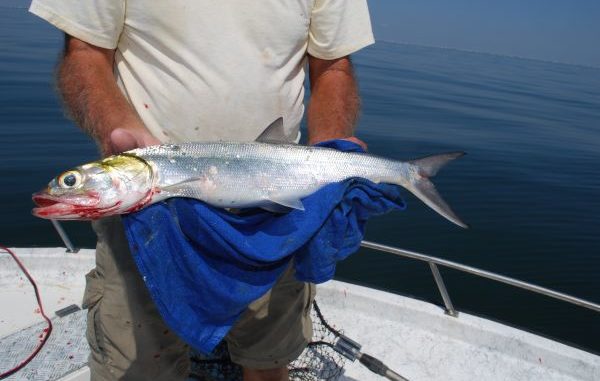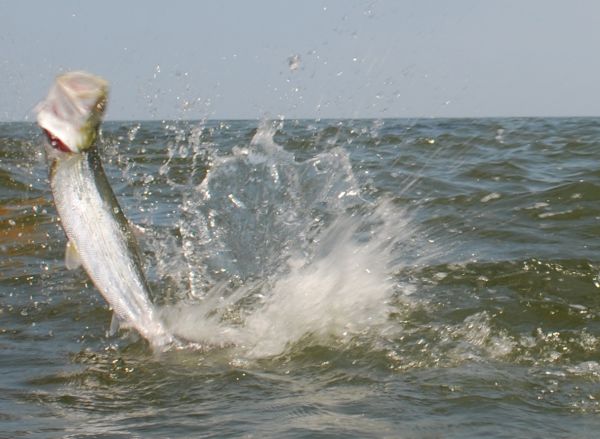
A look at the lowly ladyfish
“Yes, We Have No bananas Today” is the nonsensical title of a novelty song composed by Frank Silver and Irving Cohn for Broadway in 1923. Like the song, the little fish that Louisiana coastal anglers call “banana fish” is self-contradictory.
It aggressively attacks natural and artificial baits, especially shiny, artificial lures. Then it fights wildly, putting on a great aerial show.
Most anglers who hook them can’t help but be impressed by their game qualities, while at the same time feeling unfulfilled by their catch.
They are slimy and hard to hold for unhooking, bleed copiously from any nick and are utterly worthless on the dinner table.
They don’t even have a good reputation as cut bait.
The fish, known to scientists as Elops saurus, bears the more-proper common name of ladyfish, as well as another nickname — “tenpounder,” used elsewhere, but not in Louisiana.
Of course, the latter nom de guerre is self-contradictory as well.
It never, ever reaches 10 pounds. The world IGFA world record is an even 8 pounds and was taken in Brazil in 2006.
Louisiana’s record fish of 4.64 pounds was taken the same year by Jim Sisco in Lake Pontchartrain.
Its scientific name is interesting. “Elops” translates from Greek as some kind of serpent and “saurus,” which is Greek as well, means lizard. So the name translates as “serpent lizard,” a fairly accurate description, as the fish does have a certain reptilian look.
That look gives away its status on the fish family tree. Ladyfish are a primitive species, barely more advanced on the evolutionary scale than garfish (which are older than dirt) and beneath eels.
Seven species are in its family, only two of which occur in North America: our guy and a Pacific Ocean version called a “machete” that, come to think about it, would be a descriptive name for our ladyfish, as well.
The closest relative to ladyfish found in our waters is the tarpon. At first glance, they seem to bear little resemblance to each other, but a fast camera that can freeze a ladyfish in mid-jump will reveal a remarkable resemblance between the fighting behavior of the two species.

Ladyfish and tarpon share two other characteristics that show their close relationship. One is a gular plate, a flat, boney plate located between the lower jaws of each fish.
The other is less noticeable to the average angler unless he or she hits the surf with a small-mesh seine. Right after hatching, both species (and bonefish, as well) have what are called leptocephalic larvae. These have ribbon-like bodies, very flattened from side-to-side, long fangs in small heads, tiny fins, and they are completely colorless and transparent. They also lack gills and red blood cells.
Oddly, in spite of the fangs, newly hatched larvae don’t feed with their mouths, but rather absorb nutrients and oxygen directly from the water. As the larvae develop, they begin to feed on microscopic animals (zooplankton) and then insects, and small fish and grass shrimp.
Interestingly, scientists have never been able to identify ladyfish eggs, so exactly where they spawn is still a mystery. Ladyfish larvae and juveniles are common in estuarine waters, including beaches.
Their leptocephalus larvae can be nearly 2 inches long, and in another peculiarity to the species the larvae shrink in length as they grow older and develop into juvenile ladyfish.
Ladyfish have been collected from waters almost completely fresh, although they are much more common in brackish and saline waters.
After two or three years, they leave estuarine waters to move offshore, where they are thought to spawn. Adults can be found in waters as deep as 160 feet. Maximum life span for the species is six years.
Like tarpon, ladyfish are fairly tolerant of low oxygen conditions, although unlike tarpon they cannot “breathe” by taking in air directly from above the water’s surface.
Ladyfish are sensitive to cold water temperatures, and are seldom found in waters below 52 degrees Fahrenheit. In Florida, they have been killed in numbers in stiff cold snaps.
Ladyfish have a mouth full of small but sharp teeth, and are strict carnivores. They feed on a variety of species, including menhaden, silversides (glass shiners), mullet and even their own kind. Crustaceans, especially shrimp, are also taken.
Food items, whether fish or shrimp are swallowed whole.
A 1958 study done in Lake Pontchartrain showed 82 percent of their diet was fish and another 10 percent was shrimp and crabs.


